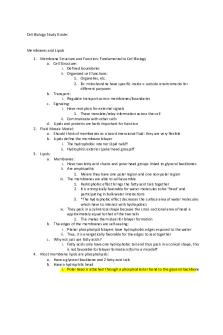AP Biology Study Guide 1 PDF

| Title | AP Biology Study Guide 1 |
|---|---|
| Author | Maile Bartow |
| Course | AP Biology |
| Institution | High School - USA |
| Pages | 4 |
| File Size | 176.1 KB |
| File Type | |
| Total Downloads | 113 |
| Total Views | 215 |
Summary
The first Unit of AP Biology...
Description
AP Biology Study Guide 1 Water Properties: Cohesion- Hydrogen bonding between LIKE molecules (ex. water with water) Adhesion- Hydrogen bonding between UNLIKE molecules (ex. water with a leaf) Capillary Action- the movement of a liquid through a narrow space as a result of the forces of cohesion, adhesion, and surface tension. (ex. Moving ground water from wet areas of soil to dry ones.) Universal Solvent- Water is referred to as a universal solvent because it dissolves more substances than any other liquid. Hydration Shell- the sphere of water molecules around each dissolved ion. Moderation of Temperature- water moderates air temperature by absorbing heat from the air that is warmer and releasing stored heat to the air that is cooler. Density- water is LESS dense as a SOLID than a LIQUID (this is because of water’s hydrogen bonds) Polarity- water is a polar molecule because of the unequal distribution of electrons. High Specific Heat- water has an unusually HIGH specific heat, this is how water is able to maintain its homeostasis and keep the ocean habitable. Macromolecules: Carbohydrates: Elemental Makeup: Carbon, Hydrogen and Oxygen Monomer: Monosaccharides (ex. Glucose & Fructose) Polysaccharides: Cellulose: Strengthens cell walls Starch: Stores glucose for energy (plants) Glycogen: Stores glucose for energy (animals) Chitin: Strengthens exoskeletons and fungal cell walls Key Function: Fuel, Carbon source to be converted to other molecules or into polymers
What determines its directionality? → Dehydration Synthesis Lipids: Elemental Makeup: Carbon, Hydrogen, Oxygen, and sometimes Nitrogen, or Phosphorus Monomer: No specific monomer (ex. Fatty acids & glycerol are both monomers of lipids) Phospholipids: These make up the lipid bilayer of membranes (Hydrophilic head + Hydrophobic tail) Saturated vs. Unsaturated Fat: Unsaturated fats contain double bonds, while Saturated fats do not contain double bonds. Key Function: Energy source, lipid bilayers, and cell membranes. 4 Different Types of Lipids: ★ Cholesterol ★ Fatty Acid ★ Triglyceride ★ Phospholipid Proteins: Elemental Makeup: Carbon, Hydrogen, Oxygen, and Nitrogen Monomer: Amino Acids Key Functions: ★ Catalyze Chemical Reactions ★ Structural Support ★ Store Amino Acids ★ Transport Substances ★ Coordinate Original Responses ★ Receive signals from outside cell ★ Cell Movement ★ Protect against Disease Protein Folding:
BONDS (SUPER IMPORTANT): PRIMARY- PEPTIDE SECONDARY- HYDROGEN BONDS TERTIARY- HYDROGEN, HYDROPHOBIC, IONIC, SULFIDE QUATERNARY- SAME AS TERTIARY, BUT WITH 2+ CHAINS
Amino Acid: Carboxyl group, R group, and amino group (the R group differentiates an amino acid from another) ★ THERE ARE 20 DIFFERENT AMINO ACIDS
Nucleic Acids: Elemental makeup: Carbon, Hydrogen, Nitrogen, and Phosphorus Types of Nucleic Acids: DNA: ★ Stores hereditary Info ★ Nitrogenous bases: Adenine, Guanine, Cytosine, and Thymine (THE GENE CAN ACHIEVE) p RNA: ★ Varies in function during gene expression ★ carries DNA instructions to ribosomes ★ Nitrogenous bases: Adenine, Guanine, Cytosine, and Uracil (U CAN GET As) 3 Parts to a Nucleotide: Nitrogenous base, sugar, and phosphate group
Dehydration Synthesis vs. Hydrolysis: Dehydration Synthesis (aka condensation): ★ Takes Water ★ Makes Polymers ★ Monomers → Polymers ★ A+B → AB
Hydrolysis: ★ Gives Water ★ Breakdown Polymers ★ Polymers → Monomers ★ AB → A + B...
Similar Free PDFs

AP Biology Study Guide 1
- 4 Pages

Biology Semester 1 Study Guide
- 7 Pages

Biology - Study Guide Quiz 1
- 8 Pages

Biology DNA Study Guide
- 5 Pages

Cell Biology Study Guide
- 37 Pages

Biology Midterm Study Guide
- 27 Pages

AP Psych Units 1-7 Study Guide
- 64 Pages

AP Psychology - Unit 1 Study Guide
- 10 Pages

AP Biology notes unit 1
- 9 Pages

AP Stats Test 1 Study Guide copy
- 2 Pages
Popular Institutions
- Tinajero National High School - Annex
- Politeknik Caltex Riau
- Yokohama City University
- SGT University
- University of Al-Qadisiyah
- Divine Word College of Vigan
- Techniek College Rotterdam
- Universidade de Santiago
- Universiti Teknologi MARA Cawangan Johor Kampus Pasir Gudang
- Poltekkes Kemenkes Yogyakarta
- Baguio City National High School
- Colegio san marcos
- preparatoria uno
- Centro de Bachillerato Tecnológico Industrial y de Servicios No. 107
- Dalian Maritime University
- Quang Trung Secondary School
- Colegio Tecnológico en Informática
- Corporación Regional de Educación Superior
- Grupo CEDVA
- Dar Al Uloom University
- Centro de Estudios Preuniversitarios de la Universidad Nacional de Ingeniería
- 上智大学
- Aakash International School, Nuna Majara
- San Felipe Neri Catholic School
- Kang Chiao International School - New Taipei City
- Misamis Occidental National High School
- Institución Educativa Escuela Normal Juan Ladrilleros
- Kolehiyo ng Pantukan
- Batanes State College
- Instituto Continental
- Sekolah Menengah Kejuruan Kesehatan Kaltara (Tarakan)
- Colegio de La Inmaculada Concepcion - Cebu





